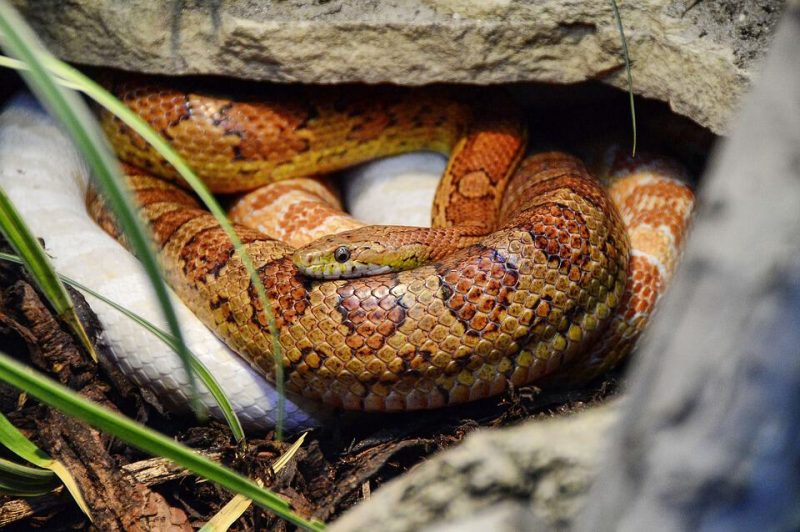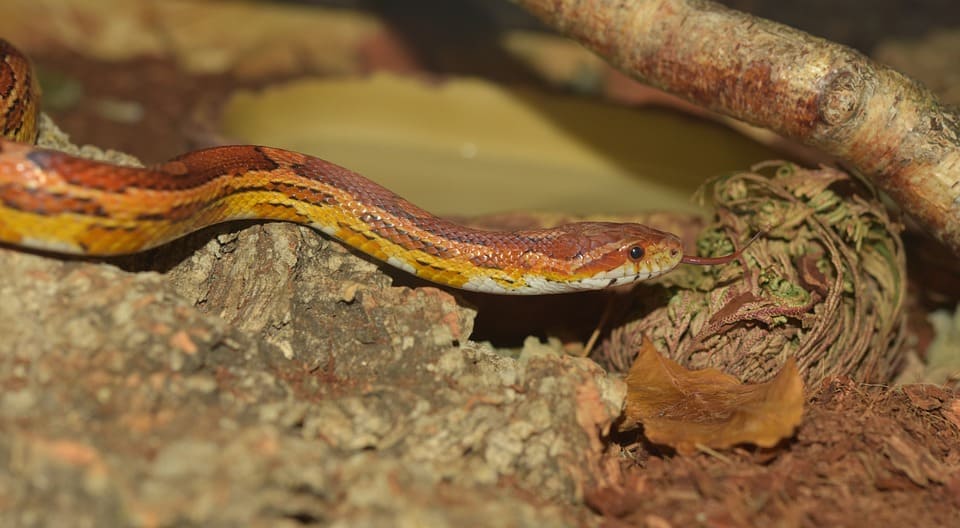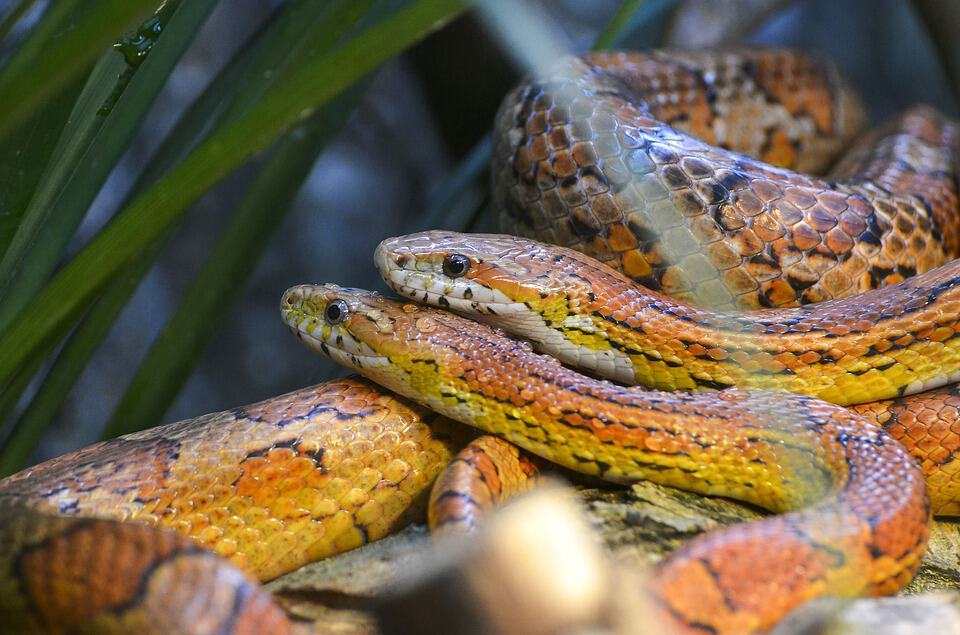Providing the proper habitat for your new pet corn snake is one of the most important things you’ll do as a keeper. Your snake’s habitat effectively becomes his entire world. Many of the health problems that afflict captive snakes can be traced back to improper habitat design and maintenance, so it is imperative that you acquire the proper enclosure and set in up in a sensible manner.
One of the neat things about corn snakes is their ability to thrive in either utilitarian or natural-looking habitats.
You can maintain your pet in a spartan, relatively “sterile” habitat, or you can decorate it so that it looks like a small version of the corn snake’s natural habitat. In fact, many keepers who’ve maintained public corn snake exhibits (including yours truly) have set up corn snake habitats that mimic the forests, wetlands and farms in which these snakes thrive.
Quick Navigation
Natural Habitat: Where Do Corn Snakes Live?
Wild corn snakes are primarily confined to the southeastern United States. Their range essentially covers the area stretching from Louisiana to North Carolina, and scattered pockets of corn snakes can be found as far north as New Jersey. Corn snakes are even found living in the Florida Keys.
Within this range, corn snakes inhabit several different types of habitats. Historically, corn snakes were likely most common in the hardwood, pine, and mixed forests of the southeast, and some individuals undoubtedly inhabited fields and wetlands too. Once humans began altering the North American landscape, corn snakes also began living in the farms they created.
Modern corn snakes inhabit the same types of forests, fields and wetlands they always have, and they’ve also managed to populate farms and other disturbed areas, ranging from backyards to gardens to vacant lots.
Corn Snake Tank Size
Corn snakes are relatively inactive snakes, who don’t need particularly large enclosures. Generally speaking, they require a habitat with a perimeter that measures twice their body length. In other words, a 2-foot-long young individual would require a habitat with a 4-foot perimeter. Similarly, a 6-foot-long adult would require a habitat with a 12-foot perimeter.
However, these should represent the minimal requirements – you can always provide your snake with a larger habitat if you like. Some advanced keepers report that large habitats can make snakes feel insecure, but this is simply incorrect. It is true that large empty habitats may make snakes feel nervous or exposed, but they’ll feel completely at ease in complex habitats with plenty of visual barriers and hiding spaces.
Corn snakes don’t necessarily need habitats that provide a great deal of vertical height, but because they are avid climbers, it is often helpful to do so.
>Further Reading: Corn Snake Care Sheet: A Simple (But Complete) Guide for Beginners
Heating and Temperature Range for Your Corn Snake Enclosure
Corn snakes are ectothermic animals, whose body temperature fluctuates with the ambient temperatures. This means that you must manage the temperatures in your pet’s habitat carefully.
The best way to do so is by establishing a thermal gradient. This means that the habitat should provide your snake with a range of temperatures – this way your snake can move around the habitat to adjust his body temperature.
Creating a thermal gradient is pretty easy; you simply need to place the heating device at one end of the enclosure. The spot closest to the heating device becomes the basking spot, while the far side of the habitat will then serve as a cool retreat, which your snake can use when he needs to cool off.
Heat lamps are typically the best heating devices for beginners, but you can also use heat pads, heat tape or radiant heat panels. Just be sure that you invest in a good digital thermometer so that you can monitor the temperatures carefully. Place the thermometer at one end of the enclosure and position the remote probe (if present) at the opposite side of the habitat.
Shoot for a basking spot temperature of about 90 degrees Fahrenheit. The temperature should fall with increasing distance from the basking spot, with the cool side of the habitat remaining in the low- to mid-70s. It isn’t always possible to achieve such a drastic gradient in small habitats, but this should be your goal.
It is generally wise to turn the heating devices off at night, to mimic the temperature drop that occurs outdoors. Just be sure that your pet’s habitat doesn’t drop below the mid- to high-60s. If it does, you’ll need to add a nocturnal, light-free heating device to the habitat to prevent your pet from falling ill.
Suitable Humidity in a Corn Snake Terrarium
Temperature isn’t the only thing you need to monitor for your pet corn snake – you must also monitor the humidity level in the habitat. Fortunately, corn snakes will tolerate a fairly wide range of humidity levels, unlike some other snakes, which have fairly specific humidity requirements.
As a ball-park figure, shoot for a humidity level in the 50% to 70% range. If you keep the habitat much drier than this, your snake will likely have trouble shedding properly; keep it wetter than this, and your snake may develop bacterial and fungal infections.
There are several ways to raise the humidity level of your corn snake’s habitat (because of the presence of the heat lamp, it’ll rarely be necessary to reduce the habitat humidity in practice). You can use a moisture-retaining substrate and dampen it periodically, or you can simply provide a larger water dish. You can also mist the habitat regularly or reduce the amount of ventilation (carefully) to increase the relative humidity.
Another approach that is often helpful is to provide your snake with a moist retreat. This is essentially a hide box that’s kept slightly damp by keeping a layer of moistened moss or wood chips inside. This gives the snake a chance to rest in a high-humidity environment when necessary, without forcing them to remain in a damp habitat at all times.
What Is the Best Corn Snake Bedding?
There are a variety of different beddings you can use for your snake’s habitat. Some of the best include:
- Newspaper or Paper Towels – Newspaper and paper towels are excellent substrates for beginners and any other keeper who likes to keep things simple. Not only are these substrates free (or nearly so), they make it very easy to keep the habitat clean. Contrary to what some new keepers think, your snake probably doesn’t care whether or not his habitat looks “natural.” As long as their needs are met, they’re typically “happy” with simple substrates like these. Just be sure that you change the newspaper or paper towels when they become soiled.
- Aspen Shavings – Aspen mulch is one of the most popular choices among professional corn snake breeders (although many opt to use newspaper instead). Aspen is safe for corn snakes, it is relatively affordable, and it smells quite nice. You can also “spot clean” aspen shavings, instead of having to change the entire substrate such as you would when using newspaper. Just be sure that you keep the shavings pretty dry, as aspen will rot when allowed to remain wet.
- Cypress Mulch – Cypress mulch is an acceptable substrate for corn snakes that some keepers (including the author) prefer above most others. Cypress mulch maintains moisture well, it lasts for a long time, and it is easy to spot clean. It’s also affordable (although this varies with your location), and it looks great.
- Orchid Bark – In a perfect world, most keepers would probably use orchid bark as a substrate for most snakes. It is attractive, it smells pleasant, it lasts for a very long time, and it’s too large for most snakes to accidentally swallow. The primary drawback to orchid bark is its price – orchid bark is quite expensive.
>Further Reading: What Do Corn Snakes Eat? A Diet & Food Guide
Corn Snake Supplies and Accessories
We’ve discussed most of the things you’ll need for your corn snake’s habitat in the preceding sections, but we’ll run them down one more time to make it easier for you to pick up everything you need.
- Enclosure
- Heat lamp and bulb
- Digital thermometer
- Water dish
- Hide box (at least one, but multiple hide boxes are ideal)
- Climbing branches
- Substrate
Remember: A Proper Corn Snake Habitat Is Critical for Success
Your corn snake’s habitat becomes his world, so make sure that you do everything possible to provide him with the best enclosure you can. Just heed the advice presented above and be sure to think about things from your snake’s point of view. This will help ensure your snake enjoys the enclosure and give him the best chance of living a long, healthy life.











52 Comments
Great insights on setting up a corn snake habitat! I never realized the importance of having both a warm and cool side in the tank. Your tips on lighting and substrate options were really helpful too! Thanks for sharing!
Our daughter left for university and the dorms won’t allow her to have her corn snake, so Salazar now lives with my wife and I. We have zero experience with reptiles beyond visits to the zoo.
We just bought him a very nice hide with both thermo and hygrometers inside, outside and a probe at the other end of his enclosure so we can keep better track of things in there (his previous cave was a hollow resin log designed for an aquarium). Our daughter has had him set up with a bio-active vivarium complete with sphagnum moss, silver sedum & sempervivum cobweb succulents, pill bugs to process the his waste and a substrate made of small round (clay?) spheres beneath rich soil. All of this runs under an LED grow light on a timer with a 5″ heat lamp in a 150 gallon front-opening vivarium.
Thank you so much for this article. I has helped me greatly in understanding how to ensure good health for him. We have been keeping it far too damp inside there because we were misting it daily, assuming incorrectly that snakes need a very humid environment (currently its 77% RH outside, 73% inside and 85% at the probe) so, we will spend the next few days allowing things to dry out via his heat lamp. We could accelerate the adjustment with a hair dryer, but I am uncertain if that’s a good idea.
We have found that he does not prefer light colored mice, but will strike and consume black mice with gusto.
How often do they need to feed? At present he eats once every 2-3 weeks. He’s just over 4 feet long. Should we increase that or decrease it?
I hope i can get a corn snake in my rtc placement. but if i do i’ll be ready.
Certainly! Corn snakes make great pets. If you decide to get one in your RTC placement, ensure you’re prepared with the right setup and care knowledge.
For detailed information, I’d recommend reading our article on corn snake care to ensure your new pet thrives.
https://www.terrariumquest.com/corn-snake-care/
Best of luck!
Hey, I’m hopefully getting a corn snake within maybe the next week or so, and I just finished setting up their enclosure. I was just wondering how I should keep everything humid enough. A spray bottle?
Hi Finneas,
Corn snakes actually require relatively low humidity, around 40-50%. If you’re keeping your snake in a place with normal room humidity, you might not need to do much. But if the air is very dry, or during shedding when higher humidity can be beneficial, a spray bottle can work well.
Misting lightly every few days should suffice. Be careful not to overdo it, as too much humidity can lead to respiratory problems.
It’s also a good idea to provide a humidity box, filled with damp sphagnum moss or similar, where your snake can go if it wants more moisture, especially during shedding.
A hygrometer can help you monitor humidity levels in the enclosure. Make sure to read more about corn snake care to ensure you’re providing the best environment for your new pet.
Best of luck with your new corn snake!